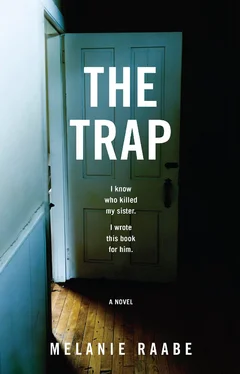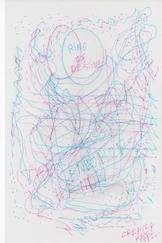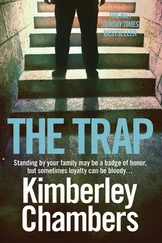With some trouble, Sophie tore her eyes from the photo and contemplated the pictures of the other employees. Three were of women and could be ruled out immediately. Another six were of men: the two managers, the art director and three computer scientists. None of them was the man Sophie had seen in Britta’s flat.
She continued to scroll down and then stopped. There were two placeholders that had names and job titles beneath them, but contained no photos. Sophie’s heart beat faster and she made a quick note of the names: Simon Platzeck, Social Media, and André Bialkowski, Programmer.
Once again, Sophie glanced at the time. What were the chances that anyone would be in the office in the middle of the night? Not very high. But what was the alternative? Go back to bed and stare at the ceiling? She got dressed, took her car key and pulled the door shut behind her.
Sophie’s body felt strangely light as she left the multistory car park adjacent to the complex where Britta had worked. Seventy-two hours without sleep. She looked about her. Of the four office buildings within eyeshot, only one had a light showing. Otherwise, the area, which would be filled with people in a few hours, was deserted: black asphalt, a few solitary streetlamps, and a few taxis speeding along the road. Sophie headed for the building where the light was showing, then stopped short. It was numbered 6-10, and Britta had worked in numbers 2–4—the dark, deserted glass block next door.
Disappointed, Sophie turned back. She took the lift and went into the underground section of the car park. The air down here felt poisonous; it reeked of exhaust fumes. Sophie rummaged in her bag for the key and had almost reached her car when the feeling hit her. She was not alone.
She stopped in her tracks: she hadn’t recognized the murderer, so she had assumed that he hadn’t known her either.
What if that weren’t the case?
He would come after her. Try to kill her, the eyewitness. There was someone there, right behind her.
She turned around, her heart thumping. No one. Her footsteps and gasping breaths echoed through the deserted car park as she hurried toward her car — nearly there now, only a few more steps. Then she froze mid-movement again. There was something there — a shadow crouching on the backseat. Or was there? No. It was trick of the light. Or was it?
The shadow moved. Sophie’s heart skipped a beat, then started galloping again. He’s going to kill me too, she thought, numbly. She wouldn’t make it. She couldn’t even scream; she could only stand there and stare. Then the spell broke. Out, thought Sophie. I must get out of here. And: Too close, I’m far too close. Three more steps and he’ll reach me. Three more steps and he’ll kill me.
At last her brain did what it was supposed to do: it tore itself free from all other thoughts and sent terror coursing through her body. The fear of death came like a surge of icy cold water, drenching her body, her clothes, her hair, and momentarily taking her breath away. Then the paralysis ended and Sophie’s body switched into survival mode.
She turned and ran, and the crouching shadow emerged from her car and began to run too. He was fast and he was coming closer. How fast can you run, Sophie, how fast? She ran toward the exit, her heart pounding, her breathing shallow, the man and the knife right behind her. She crashed into the lift doors and frantically pressed the button, rapid footsteps behind her. She didn’t turn around; she thought of Orpheus in the Underworld — turn around and you’re dead, turn around and you’re dead — and the lift didn’t come, didn’t come, didn’t come, didn’t come, didn’t come, didn’t come. Sophie ran to the stairs, heaved open the creaking steel door, burst through, and headed up the stairs. She heard the door slam shut behind her with a loud crash. Had the man with the knife taken the lift? What if he had taken the lift? What if the man with the knife was waiting upstairs, if…?
With a brutal shriek, the staircase door opened below and footsteps began to sound up the stairs. Sophie ran on, the taste of metal in her mouth, stumbled, struggled to her feet, carried on, the man with the knife behind her, closer and closer. Don’t turn around, don’t turn around. Turn around and you’re dead. What if he throws the knife — just throws it? At your back?
Sophie came to the exit of the underground car park, hurled herself at the door, but it was locked. How can it be? Oh, please — if he gets you, you’re dead — please, pretty please, open. Locked — and right behind her, the man with the knife, right behind her, the footsteps coming closer. Again, Sophie hurled herself at the door, and this time it sprang open. It hadn’t been locked, not even jammed; she hadn’t pressed the handle down firmly enough. Too stupid to open a door…Run, Sophie, damn it, don’t think, run!
Sophie plunged into the open and ran. Along the front of the deserted building, along the deserted street, the footsteps and the knife behind her — black blood, Britta’s open eyes, the look of surprise on Britta’s face, and the figure in the shadows, the figure in the shadows. Sophie ran and ran and ran and ran, until she no longer knew where she was, until she could no longer hear anything but her own footsteps and her own breathing. Only then did she stop.
No, I don’t pull the trigger. I draw the gun and point it at Lenzen with trembling hands, but I don’t pull the trigger. I’d sworn to myself that I’d only use the gun as leverage. I am a woman of words, not weapons; I had a long, hard struggle making up my mind to get ahold of a firearm, although I did, in the end, decide it was necessary.
And now I have been vindicated.
I don’t pull the trigger, but the mere sight of the gun has the same effect on Lenzen as if I’d already fired it. He’s as rigid as a corpse, looking at me with vacant eyes. I grip the gun more tightly; it’s heavy. I stare at Lenzen. He stares at me, and blinks. He’s understood: the table we’re sitting at has rotated a hundred and eighty degrees.
“My God,” says Lenzen. His voice is trembling. “Is”—he swallows—“is it real?”
I don’t reply. I’m not answering any more questions. Things have reached a state of emergency. The times of neat and elegant solutions involving DNA samples or a voluntary confession are over. I do not use the word “emergency” lightly. I am prepared to get my hands dirty. No more skirmishing. No games.
Lenzen is sitting before me with raised hands.
“For heaven’s sake!” he says. His voice sounds hoarse. “I don’t understand what’s…” He falters and breaks off, struggling to retain his composure.
His forehead is beaded with sweat and I can see from his heaving chest how rapidly he’s breathing. He looks as if he’s in deep shock. Did it really not occur to him that I might be armed? Surely he was aware of the possibility when he agreed to visit the woman whose sister he’d killed! The look of horror on Lenzen’s face disconcerts me. What if…?
I brush aside all doubt. Lenzen is going to leave this house a self-confessed murderer. There is no alternative.
I recall what I learned from Dr. Christensen: the Reid interrogation technique. Create stress. Wear down the suspect with endless questions. Punish any inconsistencies. Intersperse banal and undemanding questions with provoking and stress-inducing ones. Resort to false evidence, blackmail, force — anything goes.
Put the suspect under stress. Wear him down. Put him under stress. Wear him down. Eventually offer him confession as a way out. Put him under stress. Wear him down. And, finally, break him.
But first of all, I must find out whether he is armed.
Читать дальше












